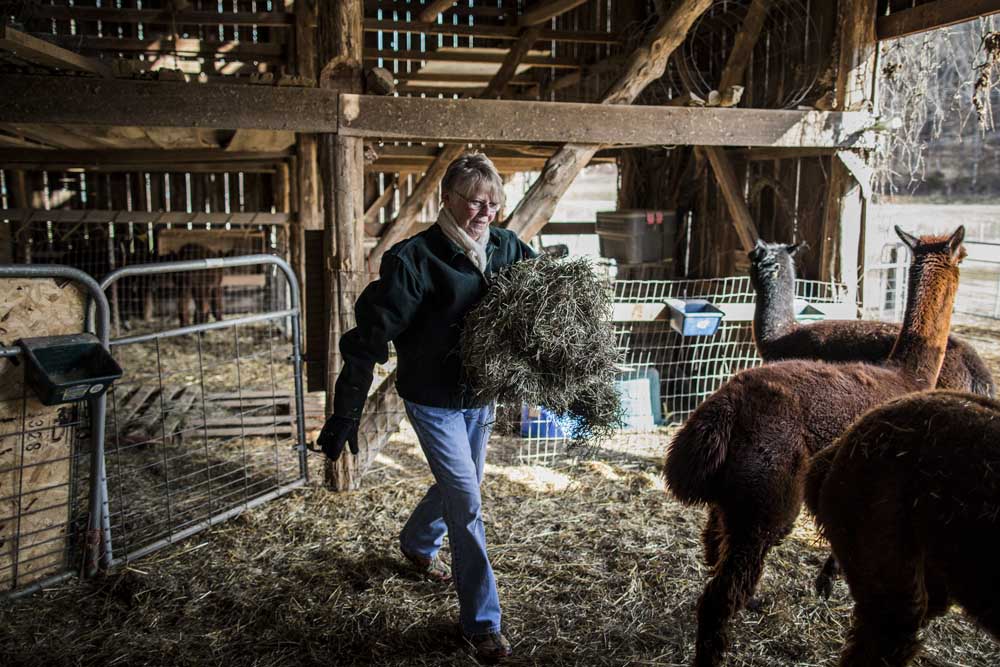To stay active in older age, more retirees turning to hobby farms
Published 6:24 am Friday, February 17, 2017

- Suzie Conn feeds her alpacas at her farm, Willow Creek Alpacas, in College Grove, Tennessee, which is sustained more as a source of fun rather than a business.(Joe Buglewicz/The New York Times)
Suzie Conn, a longtime advertising executive from Nashville, had never even seen an alpaca until moving to the country and showing up at a county fair.
“I didn’t even know how to spell the name,” she said.
But she was instantly smitten, and now these gentle, fuzzy relatives of the llama are an important part of retirement life for Conn and her husband, Gary, who had a long career in sales. The couple, both 70, raise alpacas on the 6.5-acre farm they bought in preparation for retirement about 16 years ago in College Grove, Tennessee, nearly 40 miles southeast of Nashville.
They sometimes earn a small profit — though they mostly just break even — by selling some of their herd, along with the soft alpaca fleece and fleece products Conn learned to knit and crochet. “I’m not in it to make money,” she explained. “I’m in it because I like the lifestyle. It’s a fun lifestyle.”
So-called hobby, or lifestyle, farms like the Conns’ have been sprouting up across the country in steady numbers. They have been particularly popular among retirees or people close to retiring who are looking to remain productive as they age while fulfilling lifelong passions or just tackling new endeavors.
“We see a very strong appetite to stay active and to find something meaningful,” said Catherine Collinson, president of Transamerica Center for Retirement Studies. “People are living longer, with life expectancies in their 80s and 90s, so that’s a lot of decades to fill your time. The desire to build and grow things in nature is extraordinary and quite inspiring.”
Hobby farms vary widely in size and focus, with the majority of them incorporating both crops and animals — and, more often than not, some chickens, said Roger Sipe, group editor of Hobby Farms and Chickens magazines. The farms can be close to cities or in remote outposts, he said, and they can be as small as a half-acre or spreads exceeding 50 acres.
Some hobby farmers manage to generate a secondary income, often by selling their products at farmers’ markets and at craft shows, as Conn does, or from animal breeding. Nearly all these farmers, though, many of whom are on fixed incomes, are happy to at least save on their grocery bills by raising or growing their own food.
Wendy Webster, 57, a recently retired teacher’s aide, enjoys having a ready supply of goat cheese for her family and neighbors from her 2-acre farm near Gig Harbor, Washington. She and her husband, Keith, who is also 57 and continues to work in the local school district, raise and sell Nigerian dwarf goats. They own eight of them now. They also grow fruit trees and blueberries, along with vegetables like green beans, cucumbers and squash.
The secret to success, she and others say, is to start slowly. “I see people who have a lot of money go out and buy everything they need right away, and all of a sudden, they have a big herd of goats and it’s overwhelming,” said Webster, who was exposed to farm life growing up in Tacoma, Washington, and as a longtime member of the 4-H club. “Farming is often romanticized, but it’s not very glamorous being a farmer, no matter what you’re farming.”
Conn’s hobby farm was years in the making. She and her husband bought their Tennessee property while they were still working — they were willing to put up with a longer commute for a more bucolic setting. And once they agreed on raising alpacas, they started by purchasing two pets, or “fiber boys,” before investing in the more expensive females. “That’s probably the best way to do it,” she said. “I’ve seen people who go into it and buy 30.”
Before she began planting her 6-acre hobby farm in Landrum, South Carolina, Kathy Merlino, 63, enrolled in a rigorous master gardener program at Clemson University’s cooperative extension. Through some trial and error, she harvested thriving crops of blueberries, blackberries, figs, grapes and strawberries, along with heirloom tomatoes, asparagus and other vegetables.
“I wanted to grow vegetables and fruits, and I wanted to understand what it took to grow them,” said Merlino, who retired early from a career in banking and commercial real estate.
“If you’re going to find a farm, find out about the courses you can take first. If you’re going to run it as a business, you need to take business courses.”






